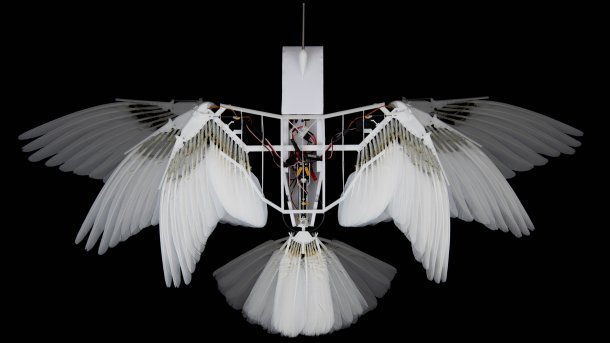PigeonBot II: robotic bird demonstrates energy-efficient flying
Birds fly particularly energy-efficiently. Their control mechanisms also contribute to this. This could be a model for airplanes.

The structure of the robot bird with the adjustment options for the wings and tail.
(Image: Eric Chang / Lentink Lab)
Researchers at the University of Groningen have developed a robotic bird with real pigeon feathers that uses the same control mechanisms as a biological bird. It is controlled by changing the shape of the wings and tail. This allows the robotic bird to be controlled in an energy-efficient manner.
The robotic bird consists of a body to which movable, skeletal wings are attached. The wings are fitted with pigeon feathers, as shown in the study "Bird-inspired reflexive morphing enables rudderless flight", published in Science Robotics. The same applies to the robot's tail. The wings and tail can be adjusted using an electric motor. This imitates the movements that a bird makes in flight.
Reflex control
Nine servomotors are used for this. They are controlled by algorithms that move the feathers. This happens reflexively in flight, similar to biological birds. Sensors provide the current flight position of the robot bird. The data is evaluated onboard and serves as the basis for further flight control. The algorithms then ensure that the bird is stabilized accordingly and can also react to changes in flight.
Birds fly much more energy-efficiently because they do not use a vertical stabilizer to change direction sideways. The research, led by David Lentink, Professor of Biomimetics at the University of Groningen, could be used to advance the development of fuel-efficient aircraft.
"The European Airbus Group has drawn up a concept that shows what such an aircraft should look like. Our study provides the knowledge to realize their ideas," says Lentink.
Empfohlener redaktioneller Inhalt
Mit Ihrer Zustimmmung wird hier ein externes Video (Kaltura Inc.) geladen.
Ich bin damit einverstanden, dass mir externe Inhalte angezeigt werden. Damit können personenbezogene Daten an Drittplattformen (Kaltura Inc.) übermittelt werden. Mehr dazu in unserer Datenschutzerklärung.
In addition, the design without a vertical stabilizer also reduces the radar signature of an aircraft. This could have advantages for military aircraft, for example.
(olb)